Signs of Spring
March 25, 2009 by admin
Filed under Shade Gardening, Spring, Spring Bloomers, Techniques
At 7:44 AM on March 20 the Sun crossed the celestial equator heading north. In common parlance, that translates to: spring is here!
It didn’t take long for wildlife to answer the call. Two days later, I awoke to the sound of a red-breasted robin singing at 6:00 AM. The cardinals have been getting redder and redder and going great gangbusters for weeks with their impressions of distant car alarms, but they’re here year round. The robin was the first migrant I’d heard stretch its vocal cords this year.
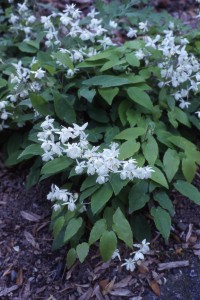
Epimedium x youngianum 'Niveum' in its April glory
While the robins celebrated spring by completing the last leg of their long journey, I was out in the garden performing one of the first jobs necessary to the season: uncovering my epimediums. (They have a common name—bishop’s hat—but somehow I just can’t bring myself to use it. They’ll always be epimediums to me.)
Along with hellebores and lungworts, epimediums start growing actively in March long before many of us have gotten out to remove the leaves that blew into the garden late last year after the rake had been put away for its long winter’s nap. (Or was it the gardener determined to nap? Tools can be convenient excuses…)
If you live on a lot with many trees, no matter how much you raked and blew last fall, you might find a lot of leaves staring up at you from the garden when the snow melts. Many plants can benefit from that cozy little coverlet, but for others it’s a problem.
While hellebores and lungworts are sturdy plants that can withstand the inevitable manhandling that occurs when you peel away sopping wet mats of oak leaves, epimediums are delicate little things with fragile stems all too easily snapped off. Wait even a week too long to clear them of leaf litter, and you may not be able to do it without surgical tools. (I exaggerate, but not by much.)
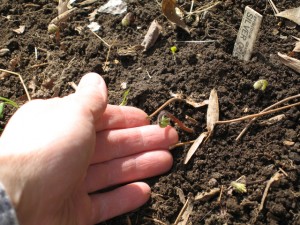
New epimedium growth under the leaf litter in March
At left is a picture of a curled epimedium flower stalk taken on March 20 just after being uncovered. This happens to be a patch of E. ‘Silver Queen’, a large-flowered white variety. In just a few weeks, it will put on a display to rival the extravagant bloomer E. x youngianum ‘Niveum’ shown in the picture above.
As careful as I tried to be when I removed the errant leaves, I wasn’t careful enough. Below left is a photograph of a stalk that I clumsily damaged. It takes almost no force to snap the top off these little guys, and that’s one spray of flowers less for me, the bees and everyone else this spring.
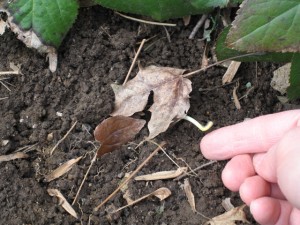
Epimedium stalk accidentally broken off
Some epimediums have fairly persistent stalks that don’t disintegrate on their own over winter. While you might not have to groom ‘Niveum’ at all, most others aren’t as accommodating. E. x perralchicum ‘Frohnleiten’ has perhaps the most evergreen leaves of any epimedium. This is both a plus and a minus. In snowless winters, they’re something to look at. But snow or no snow, in spring they’ll require cleanup. A pair of hedge clippers is the tool for this task. They do the job quickly and with all the precision required. You could just leave last year’s foliage alone, and new growth would come up through it and eventually conceal it, but most epimediums look better with a figurative shower and shave.
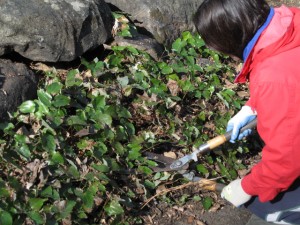
Shearing back epimediums in mid March
Unless you mulched last autumn, have some light, compost-based mulch handy to spread on your epimediums as soon as you uncover them. Otherwise, the soil around them will dry out quickly. At this time of year the sun is surprisingly intense, although most of us aren’t aware of it because air temperatures haven’t climbed yet. But I’ve learned that when I come out of my winter semi-hibernation and start working outdoors up to eight hours a day in March and April, I’d better wear sunscreen! New growth of shade-loving plants should also have some protection, not from the sun itself, but from the soil dryness it can cause.
Of course, even if I didn’t remove the leaves from my epimediums, they’d grow right up through their brown blanket and bloom anyway. But I prefer the look of a clean bed with a dressing of compost as a nice backdrop. Knowing that the job of removing those leaves without damaging the epimediums becomes harder with each passing day is enough incentive for me to get outside in mid March no matter what the weather. Ironically, as intolerant as they are of mishandling, fresh new epimedium growth will have no problem withstanding freezing nights.
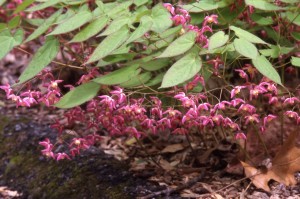
The reason for the work of the season. Darn—where'd that leaf come from?!
Spring Blooming Shade Plants: Hellebores
March 18, 2009 by admin
Filed under Perennials, Shade Gardening, Spring Bloomers
In a typical year, hellebores will be the first ornamental perennial to bloom in the Northeast. Although there are several species that can be grown in this region, especially in milder areas such as the coast and the lower Connecticut River Valley, one of the hardiest remains my favorite: Helleborus x hybridus (formerly and sometimes still known as Helleborus x orientalis).
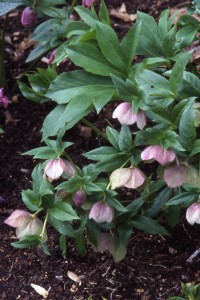
Helleborus x hybridus
Here in northwest Connecticut, hellebores send up their flower buds first, in March, before their leaves unfurl. As the month goes on, these succulent and tender looking shoots grow taller and taller, until they finally open up around April 1 to reveal clusters of 2″-wide, pendant blossoms. The species H. x hybridus is quite variable, with a range of subtle flower colors including creamy white, apple green, pale pink and burgundy. Its flowers often have striking speckled markings and prominent yellow anthers that are showy for about a week until the stamens fall off.
At first, hellebore flowers look a bit undressed because the plant’s leaves don’t come along until a few weeks later. When they do make their appearance, however, they are exceptionally attractive—leathery, glossy, palmate (arranged like fingers around the palm of a hand) and semi-evergreen.
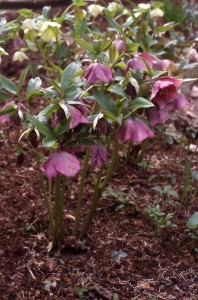
Hellebore flowers emerge before leaves
Everything about hellebores is long lasting. Instead of dropping off after 2-3 weeks, hellebore flowers slowly fade to a pale green or buff color in much the same way hydrangea flowers do. They look good (although subdued) right up to the point when the seeds mature and are dispersed, usually in the latter half of June. Deadhead them before that point unless you want seedlings the following spring. In most gardens, the leaves will remain disease free and unblemished all season long, and will still be looking good when the first snow flies.
Shade tolerance: High
Hardiness: Zone 5; other species may differ
Size: Medium sized, with a height and spread of 15-18″
Native status: non-native to any part of North America
Growing Tips
- Don’t cut back hellebore foliage in fall, even if you clean up the rest of your garden then. Why? Hellebores come up so early in the year, they are subject to damage from late frosts. These frosts won’t kill the plants, but they will kill the flower buds. As the plant’s shoots begin to emerge from the ground, last year’s leaves will provide some protection. After the new shoots have grown taller than last year’s leaves, you can groom them, cutting off the old foliage at ground level. Be careful not to accidentally cut off new growth—it’s easy to do. For a few more weeks after you groom them, it’s a good idea to keep some pine boughs or an equivalent handy to gently arrange over the new growth at night if a hard frost is in the forecast.
- Hellebores have to be several years old before they are mature enough to flower. A nursery plant in a 5-pint pot is probably only two years old, so don’t be surprised if it doesn’t flower its first (or even second) year in the ground. As long as the plant grows well and looks healthy, flowering should start when the plant is ready. A plant that fills a one-gallon pot should be old enough to flower its first spring after planting.
- H. x hybridus is often sold in a mix of undifferentiated colors. In other words, if the tag in the pot with your plant does not specify a flower color, but just says H. x hybridus, it could be any of the flower colors listed above. There’s no way to know which color you’ve got unless you buy the plant in bloom very early in the season and the plant is old enough to be blooming in the first place. In recent years, some growers have also offered hellebores in designated colors. I like the way the mixed colors look in the garden when hellebores are massed, but gardeners with color-theme gardens might prefer to purchase all of one kind.
- Hellebores have no special needs, but they don’t like excessive moisture. If put in exceedingly dank locations or planted in soils that drain poorly, rot of the crown may result.
- Hellebores self-sow moderately. Their seeds are large and heavy, so they don’t usually travel very far. If you don’t deadhead your plants before they drop their seeds, you’ll probably find a “skirt” of seedlings around their feet in spring. Move these to a nursery bed to mature or give them away to friends.
Bloom times and other life cycle stats are accurate for northwest Connecticut. In milder areas all aspects of a plant’s life cycle may occur earlier in the year, and in colder areas, later.
Spring!
Spring is just around the corner! Okay, not really, although according to the calendar the start of it is just two weeks away. For those of us in the North, the vernal equinox (that’s what will happen on March 20) is a purely conceptual start to spring. But the signs of the real thing are there, too, if you look. For one thing, the sugarhouses are steaming away, and “Pick up a gallon of medium amber” is on my To Do list. (Yes, I really go through a gallon of maple syrup each year. We’re having pancakes for dinner tonight.)
Outside, there are indicators that the change of seasons is under way. Just six days ago (Monday, March 2, 2009), we were blanketed by 15 inches of snow. Today, March 8, the only white stuff left is a few compacted inches in the shadow of trees and in the spots where the plows and snowblowers piled it up when the storm ended. For days, I’ve practically been able to see it melting.
This morning, with the thermometer reading a balmy 60°F (12°C), I went outside for the first of what will be many sessions picking up the detritus of winter (fallen tree branches, mainly) and pruning dead wood off various shrubs and trees. I took a moment to search for that most signal harbinger of spring: snowdrops (Galanthus spp.) As starkly obvious as little white and green flags against a sea of brown, they’re easy to pick out, even when they first emerge. What did I see? Nothing.
At 4:00 pm I went back outside to put my tools away, and my eyes were immediately drawn to several clumps of snowdrops pushing their way up into the light. Did they really shoulder aside the thick cover of last year’s fallen leaves in just a few hours? I wouldn’t be surprised. Spring is just around the corner.
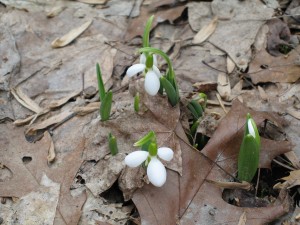
The first snowdrops of the year—March 8, 2009

